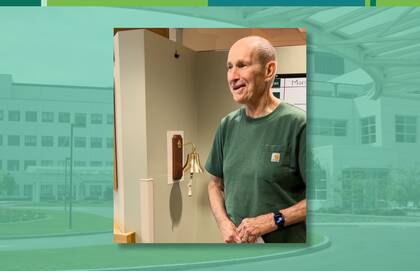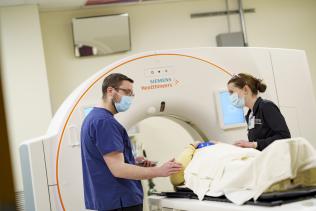Facing radiation treatment can be overwhelming. Our team is here to help you understand the steps of your treatment plan and to answer any questions you may have. Radiation oncology provides radiation treatment for many types of cancer. Different types of cancer may mean different types of radiation treatment. Your radiation oncologist will work with you during your first appointments to develop a treatment plan personalized for you, your cancer type, and your individual needs.
On this page:
- Tour the department
- Your first appointments
- Planning for your appointment
- After your consultation and planning visits
- Your first radiation treatment visit
- After your treatment
- What to do if you're having problems
Tour the department
This tour was created to allow you to explore our clinic from the convenience of your home. It was also designed to introduce you to the various steps in the radiation treatment process. We hope you enjoy getting to know us!
Click the image below for an interactive virtual tour of the department.
Your first appointments
Your medical or surgical oncologist will refer you to us for your first visit. The first step is your consultation with one of our radiation oncologists.
During your first visit, they will:
- Help determine if radiation therapy is the right treatment for you
- Review with you the benefits and risks of radiation treatment
- Take a complete history and perform a physical examination
You may also see a medical student, a resident (radiation oncologist in training), a nurse practitioner, a physician’s assistant, or a nurse.
Your second visit is usually the planning or simulation appointment.
Planning for your appointment
This section provides information on:
- What do you need to bring to your consultation appointment?
- What happens during a planning appointment?
What do you need to bring to your consultation appointment?
You may have many questions about your treatment. Write down any questions and concerns you want to bring up with your doctor. You may want to ask a friend or family member to come with you to the consultation appointment. It can be helpful to have someone with you to listen to what the doctor says. They can help you remember any questions, and take notes.
What happens during a planning appointment?
Depending on the type of radiation therapy you are having, you may have a second appointment called a planning—or “simulation”—appointment.
During the planning appointment, your care team prepares for every detail of your treatment sessions. They will take scans or X-rays to confirm the precise location of the radiation target. Precision is vital for getting the most out of your treatment and reducing side effects. Our staff may mark your skin with a temporary tattoo for reference during treatment sessions.
Physical supports
Depending on the type and location of the cancer in your body, this appointment may also include the creation of unique physical supports for you. We use supports such as a mesh guide or a bolster during each treatment.
- Mesh guide: Forming a mesh guide is like having a warm, damp towel draped over the relevant body part. As the mesh cools, it stiffens.
- Bolster: To have a bolster made, you will get into your treatment position with support from a squishy form. Then a radiation therapist will vacuum the air from the form so that it will hold its shape during your treatments.
Your radiation therapist may take a photograph of how they have arranged your body and the supports. This will serve as a guide for your future treatment appointments.
After your consultation and planning visits
Once the planning visit and the simulation are finished, your radiation oncologist works with other members of the radiation oncology team to develop your treatment plan. These team members may include a dosimetrist or medical physicist who work behind the scenes to make sure your treatment is delivered accurately and precisely.
The radiation oncology team reviews information obtained during your planning visit and your previous medical tests. They design the best possible treatment plan for you. The radiation oncologist then creates a prescription that outlines:
- Exactly how much radiation you will receive
- Which specific parts of your body will be treated
- The frequency of your treatments
Your first radiation treatment visit
It may not be until the third appointment that you receive your first radiation treatment. In a few cases, some patients may receive treatment during their first or second visit. Depending on the type of cancer, you will normally have your first treatment 1 to 2 weeks after your consultation.
During treatment, you need to lie completely still. The treatment itself is painless, but you may be uncomfortable laying flat due to:
- A previous injury
- The position you need to lay in for treatment
- Pain from your cancer
We can help with medications to help make treatment more tolerable.
While the actual time you will receive treatment is usually less than 15 minutes, your entire appointment time may be longer.
You will be alone in the room while you are receiving the radiation. The technologist can see you on a TV screen and can hear you through an intercom. The length of treatment is different for each method of treatment. The number of treatments will depend on your type of cancer and the treatment plan designed by your physicist and doctor.
After your treatment
Radiation therapy is not painful during the treatment session. Side effects that you may have after you begin radiation therapy can cause pain and discomfort. You may experience:
- Diarrhea
- Fatigue
- Hair loss
- Mouth changes
- Nausea
- Pain
- Skin changes
- Vomiting
Your doctor and the nursing staff will monitor you over the course of your treatments to assess for side effects and help manage them.
What to do if you're having problems
Please contact us about any change in your condition, especially if you are experiencing any discomfort. If you are unable to make a scheduled appointment because of an emergency, call the Radiation Oncology Department at the location where you are receiving treatments. View contact information for each of our locations.


